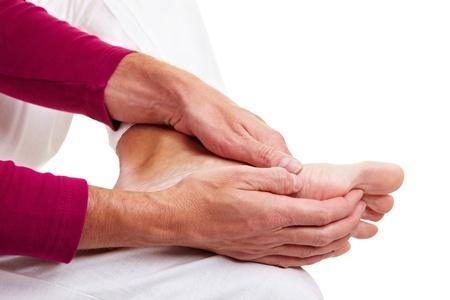
Those who have diabetes are at risk for developing diabetic neuropathy. In particular, it can affect the hands and feet, putting them in danger of injury without feeling it. Since the feet keep you mobile, it’s important to make sure that they are kept in tip-top shape. Otherwise, even a small cut can become an infection that goes unnoticed until it is very severe.
To protect yourself from diabetes-related foot complications, you should perform regular self-exams of your feet and ankles. If you have not lost sensation in your feet, do a weekly self-exam to make sure no new problems are developing. If diabetic neuropathy has already set in and you have lost feeling in your feet, perform these checks daily. If you cannot perform these steps due to flexibility or other positioning issues, recruit a family member or a home health aide to help you with your foot exams.
1.Wash your feet with warm water and soap daily. This will help reduce risk of infections and give you another chance at inspecting your feet.
2.Gently dry your feet completely before you begin the self-exam. This will reduce risk of bacterial or fungal growth between the toes. You may need to sit on a stool, chair, or your bed to fully get in between your toes.
3.From that sitting position, begin the foot exam. Visually inspect your feet. Remember to look at the soles of your feet and in between toes, using your hands to rotate the foot upward, if necessary. (If flexibility is an issue, use a mirror or ask someone to help you with the exam). Check for cuts, lumps, bumps, redness, swelling, or any other changes in the skin. You’ll need to treat any corns, calluses, bunions, cuts, or scrapes. If you notice an open wound (ulcer), contact our podiatrist right away.
4.Use your hands to feel every part of your foot for bumps or lumps that may not be visible to the eyes. Gently massage or press on parts of your feet (including the toes) to check for blood circulation and any pain or abnormal pressure. Additionally, take note of any difference in temperature along your foot.
5.Check your toenails for any signs that they are ingrown (growing into the skin) or have a fungal infection (discolored, brittle nails). These must be taken care of carefully to prevent complication, so you may want our podiatrist to handle treatment.
6.Check your skin to see if it is dry. Visually inspect your skin as you feel it. Cracked heels can be prone to infection, so be sure to moisturize dry skin.
7.Finally, smell your feet. Yes, you should check your feet, as well as socks and shoes for evidence of foot odor. Daily foot washing will help with this. As for shoes, be sure to sanitize and allow them to fully dry in between wears, as this can indicate bacterial or fungal growth that can lead to infection. If you have diabetic shoes, you may need more than one pair.
These self-exams should be performed along with regular podiatric visits for your feet. For injuries or other concerns regarding your diabetic feet, consult with our board-certified podiatrist, Dr. Brad Toll at Crofton Podiatry. Make an appointment by calling (410) 721-4505 to receive a thorough assessment at our Crofton, MD office, where our team is ready to assist you. We also serve the surrounding Gambrills, Odenton, and Bowie, MD areas.
